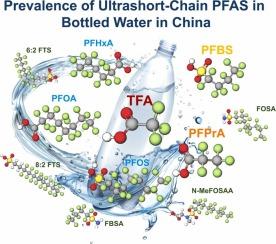中国瓶装水中的PFAS:超短链化合物的高发率、健康风险和全球洞察
IF 11.3
1区 环境科学与生态学
Q1 ENGINEERING, ENVIRONMENTAL
引用次数: 0
摘要
全氟和多氟烷基物质(PFAS)是持久性环境污染物,饮用水是人类接触的主要途径。本研究对中国52种瓶装水产品进行了50种PFAS分析,涵盖了超短链、短链、长链化合物和前体。共检测到21种PFAS, Σ21PFAS浓度范围为2.69 ~ 97.0 ng/L。超短链PFAS以三氟乙酸(TFA)和全氟丙烷酸(PFPrA)含量最多,中位浓度分别为7.40和3.98 ng/L。PFAS水平因产品类型、水源和处理方式的不同而有显著差异。泉水中Σ21PFAS的平均浓度最高(37.5 ng/L),这可能是由于泉水较浅,受地表影响,且处理较少。相比之下,在矿物质和纯净水中观察到的水平较低,特别是来自较深含水层或经过反渗透(RO)处理的水。风险商数分析表明,除全氟辛烷磺酸和全氟辛烷磺酸外,根据现有准则,大多数全氟辛烷磺酸构成的健康风险为低至极低。此外,一项全球综合研究进一步揭示了超短链PFAA和前体水平的上升,表明PFAS暴露谱正在发生变化。这些发现强调需要扩大监测、毒性评估和管理框架,以解释饮用水供应中被忽视的PFAS类别。本文章由计算机程序翻译,如有差异,请以英文原文为准。

PFAS in Bottled Water from China: High prevalence of Ultrashort-chain Compounds, Health Risks, and Global Insights
Per- and polyfluoroalkyl substances (PFAS) are persistent environmental contaminants, with drinking water serving as a major human exposure pathway. This study analyzed 52 bottled water products across China for 50 PFAS analytes, covering ultrashort-chain, short-chain, long-chain compounds, and precursors. A total of 21 PFAS were detected, with Σ21PFAS concentrations ranging from 2.69 to 97.0 ng/L. Ultrashort-chain PFAS, trifluoroacetic acid (TFA) and perfluoropropanoic acid (PFPrA), were the most abundant with median concentrations of 7.40 and 3.98 ng/L. PFAS levels varied notably across product types, water sources and treatment. Spring water showed the highest average Σ21PFAS concentration (37.5 ng/L), likely due to shallow, surface-impacted sources and minimal treatment. In contrast, lower levels were observed in mineral and purified waters, especially those from deeper aquifers or with reverse osmosis (RO) treatment. Risk quotient analysis indicated that, apart from PFOA and PFOS, most PFAS posed low to very low health risks under existing guidelines. Additionally, a global synthesis further revealed rising levels of ultrashort-chain PFAA and precursors, suggesting a shifting PFAS exposure profile. These findings underscore the need for expanded monitoring, toxicity evaluation, and regulatory frameworks that account for overlooked PFAS classes in drinking water supplies.
求助全文
通过发布文献求助,成功后即可免费获取论文全文。
去求助
来源期刊

Journal of Hazardous Materials
工程技术-工程:环境
CiteScore
25.40
自引率
5.90%
发文量
3059
审稿时长
58 days
期刊介绍:
The Journal of Hazardous Materials serves as a global platform for promoting cutting-edge research in the field of Environmental Science and Engineering. Our publication features a wide range of articles, including full-length research papers, review articles, and perspectives, with the aim of enhancing our understanding of the dangers and risks associated with various materials concerning public health and the environment. It is important to note that the term "environmental contaminants" refers specifically to substances that pose hazardous effects through contamination, while excluding those that do not have such impacts on the environment or human health. Moreover, we emphasize the distinction between wastes and hazardous materials in order to provide further clarity on the scope of the journal. We have a keen interest in exploring specific compounds and microbial agents that have adverse effects on the environment.
 求助内容:
求助内容: 应助结果提醒方式:
应助结果提醒方式:


